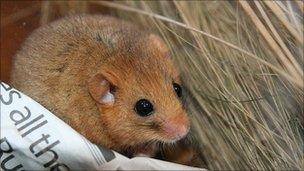'Rare' dormouse found at farm in rural Lancashire
- Published

There are an estimated 45,000 dormice in England and Wales
A tiny mammal described by the Lancashire Wildlife Trust as "rare" has put in a surprise appearance at a remote farm in rural Lancashire.
The dormouse was discovered snoozing in its nest, concealed among plastic bags, on a farm in Preesall, near Garstang.
Though more common in southern England, the Trust says there have been no confirmed sightings of dormice in Lancashire since the 1980s.
The Trust is keen to find out where the mouse, a protected species, came from.
Trust volunteer Bob Danson, who was called to confirm the sighting, said: "It was still in hibernation so the lady who found it took it home and put it in a warm place.
"To my knowledge there are no recordings of dormice locally. It is possible this came to the farm with one of many deliveries of potatoes, pheasants or fertilizer."
Small population
Since it was discovered, another farm has also reported seeing dormice, raising hopes that there might be a small population in the county.
Dr Tim Graham, Lancashire biodiversity manager for the Trust, said: "This is a very unusual discovery because dormice are very rarely found in Lancashire, so we would love to find out whether there might be a small population in the area."
UK populations of the animal have shrunk as mixed woodland of oak, hazel, sweet chestnut and other food-bearing plants have been cleared for agriculture and development.
Badly managed hedgerows, loss of traditionally managed coppices and the spread of coniferous plantations have also damaged the prospects for dormice in Britain.
The dormouse is now being cared for by Sarah Bird, Chester Zoo's biodiversity officer, who holds a special licence from Natural England to look after the animals.
"It's really exciting that one has been found in Lancashire," she said.
"They can survive in new woodland and even in conifer plantations, so long as they can find brambles and pollen to feed on.
"Once one is spotted, you start getting more sightings."
There are an estimated 45,000 dormice in England and Wales and the Lancashire Wildlife Trust now plan to carry out surveys in the autumn to see how many dormice are in the area and if more can be reintroduced.